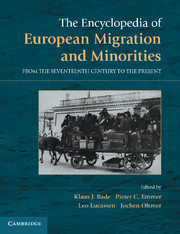Book contents
- Frontmatter
- Contents
- Preface to the English Edition
- Preface to the German Edition
- The Encyclopedia: Idea, Concept, Realization
- Terminologies and Concepts of Migration Research
- Countries
- Northern Europe
- Western Europe
- Central Europe
- Southern Europe
- East-Central Europe
- The Baltic Region: Estonia, Latvia, Lithuania
- Poland
- Czechia and Slovakia
- Southeastern Europe
- Eastern Europe
- APPENDIX
- Index of Migration Types
- Index of Countries, Regions, and Places
- References
Czechia and Slovakia
from East-Central Europe
Published online by Cambridge University Press: 05 June 2012
- Frontmatter
- Contents
- Preface to the English Edition
- Preface to the German Edition
- The Encyclopedia: Idea, Concept, Realization
- Terminologies and Concepts of Migration Research
- Countries
- Northern Europe
- Western Europe
- Central Europe
- Southern Europe
- East-Central Europe
- The Baltic Region: Estonia, Latvia, Lithuania
- Poland
- Czechia and Slovakia
- Southeastern Europe
- Eastern Europe
- APPENDIX
- Index of Migration Types
- Index of Countries, Regions, and Places
- References
Summary
The territories of the Czech and Slovak Republics, sovereign since 1993, formed a joint state – Czechoslovakia – in 1918–39 and 1945–92. From 1939 to 1945, the Slovak Republic existed formally as an independent state, while the regions of the Bohemian lands that were not directly annexed to Nazi Germany were combined into the German-occupied “Protectorate Bohemia and Moravia.” Before 1918, Czechia and Slovakia were parts of Austria-Hungary, though they belonged to different halves of the dual monarchy that existed after 1867. The Bohemian lands as part of the Austrian half of the state, and Slovakia as part of the Kingdom of Hungary, have had a separate history for most of the modern period. That applies also to the migration history of the two countries.
The following survey takes its cues from the dominant directions and forms of migration during the various periods. The section on preindustrial times therefore deals primarily with migrations caused by religious confessions. By contrast, during the “long” 19th century, the focus is on the economically motivated migration into the emerging industrial centers – as internal migration, but also overseas and to other European countries. During the first half of the 20th century, attention must be given especially to (forced) migrations brought on by ethnonational demarcations. A brief look at the situation after 1989 completes the survey.
- Type
- Chapter
- Information
- The Encyclopedia of European Migration and MinoritiesFrom the Seventeenth Century to the Present, pp. 152 - 160Publisher: Cambridge University PressPrint publication year: 2011
References
- 1
- Cited by

